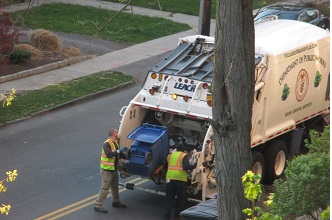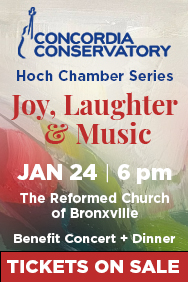Where Does Bronxville’s Garbage Go?

By Ellen Edwards
May 9, 2018: Bronxville is served by a sophisticated, state-of-the-art waste disposal system, a partnership of private and public enterprise.
In 1982, the federal government mandated that Westchester County close the Croton Point landfill because its proximity to the Croton watershed threatened the safety of that water supply. As a result, 26 towns, including Bronxville, joined together to form one district that would handle its waste. In 1988, state legislation that required municipalities to provide plans for the management of solid waste emphasized this mantra: reduce, reuse, and recycle.
It all begins when curbside trash, recyclables, and yard waste are picked up by trucks hired via an inter-municipal agreement with Eastchester and the county. Commercial enterprises in town hire private waste haulers.
Experts disagree whether landfill or combustion is the better choice for dealing with waste. Westchester chose combustion and in 1984 it completed construction of the Charles Point Resource Recovery Facility in Peekskill.
Bronxville's trash is brought to one of three county-owned transfer stations; ours is the Westchester County Thruway Transfer Station on Stew Leonard Road in Yonkers. At these stations, the garbage is compacted and loaded onto tractor-trailer trucks and then driven 30 miles north to the Charles Point plant.
Operated by the private company Wheelabrator Westchester, the enclosed Charles Point plant handles 2,250 tons of waste each day and is able to process 710,000 tons a year. It now services 36 county municipalities and 90% of Westchester County's population.
Monday through Friday, Charles Point receives residential, commercial, and special waste from which recyclable material has already been removed. Waste is transported to a tipping floor, where it is visually inspected to identify and remove any material that shouldn't be sent to the burner. Cranes transfer the material to a hopper that controls the flow of material into the boiler. Metal grates slowly move the trash through the heating process, which exceeds 2,000 degrees Fahrenheit, and massive fans blow air into the boiler to create a negative pressure that prevents dust and odors from escaping.
As hot combustion gases pass through boiler tubes filled with water, they create pressurized steam. The steam, in turn, drives turbine generators that produce electricity for sale to Con Edison. The plant produces 60,000 kilowatts of "clean" electricity an hour, or enough to supply 88,000 homes. Ten percent of the electricity generated is used to run the plant. Remaining steam is condensed to purified water and returned to the system for more energy production.
As the combustion gas leaves the boiler, it is treated with powdered carbon to remove mercury and trace organic compounds. It then passes through a "spray dryer absorber" (or dry scrubber), where lime is combined with the gas to neutralize the acidic gases (including sulfur dioxide and hydrogen chloride). As a final step, the material passes through a fabric filter (an electrostatic precipitator) to remove particulates.
After additional monitoring and data collection, the clean gas is then cooled with water from the Hudson River and released through a smokestack; the white plume that is often visible consists mostly of water vapor. For this cooling process, fifty-five million gallons of water are taken from the Hudson River each day and released back into it at a maximum temperature of 105 degrees Fahrenheit.
The ash that results from the combustion process is rich in metals such as iron, steel, copper, and aluminum, which are extracted and sold for recycling. An average of 6,000 tons is recovered each year. The remaining ash, which in 2014 amounted to 5% of the volume of waste that originally arrived at the plant, goes into landfills.
Westchester recycles about 50% of its waste--a much better record than most of the country. Plastics labeled 1 through 7, glass, metal cans, and paper are taken to the material recovery facility (called an MRF) on Stew Leonard Road in Yonkers, where they are separated, sorted, and prepared for sale to third-party manufacturers. According to a 2014 county report, such sales generated revenue of over $5.5 million and recycling overall saved the county $11.5 million. As part of its efforts to educate consumers, the county welcomes visitors to the Yonkers MRF. Go to www.westchestergov.com for details.
Yard waste comprises a substantial 15 to 20% of all waste in the county and must be collected separately. You can help the village save money, and improve your soil, by leaving your grass clippings where they fall and chopping up the leaves with a mulching mower.
A fourth part of the county's waste recovery system is the Westchester County Household Materials Recovery Facility in Valhalla. Here, by appointment, you can bring hazardous, bulky, and otherwise hard-to-dispose-of waste, where it will be either recycled or disposed of in a safe manner.
And take advantage of Bronxville's take-back day on May 19, from 10:00 am to 1:00 pm, sponsored by the village's Green Committee, when you can bring to village hall paper for shredding, electronics for recycling, and other items for donation.
Editor's note: Ellen Edwards is a Bronxville resident and a member of the Bronxville Green Committee, which welcomes volunteers.
Photo by Ellen Edwards
Editor's note: As a public service, MyhometownBronxville publishes press releases, statements, and articles from local institutions, officeholders, candidates, and individuals. MyhometownBronxville does not fact-check statements therein, and any opinions expressed therein do not necessarily reflect the thinking of its staff.
Government & History Directory
Bronxville is a quaint village (one square mile) located just 16 miles north of midtown Manhattan (roughly 30 minutes on the train) and has a population of approximately 6,500. It is known as a premier community with an excellent public school (K-12) and easy access to Manhattan. Bronxville offers many amenities including an attractive business district, a hospital (Lawrence Hospital), public paddle and tennis courts, fine dining at local restaurants, two private country clubs and a community library.
While the earliest settlers of Bronxville date back to the first half of the 18th century, the history of the modern suburb of Bronxville began in 1890 when William Van Duzer Lawrence purchased a farm and commissioned the architect, William A. Bates, to design a planned community of houses for well-known artists and professionals that became a thriving art colony. This community, now called Lawrence Park, is listed on the National register of Historic Places and many of the homes still have artists’ studios. A neighborhood association within Lawrence Park called “The Hilltop Association” keeps this heritage alive with art shows and other events for neighbors.
Bronxville offers many charming neighborhoods as well as a variety of living options for residents including single family homes, town houses, cooperatives and condominiums. One of the chief benefits of living in “the village” is that your children can attend the Bronxville School.
The Bronxville postal zone (10708, known as “Bronxville PO”) includes the village of Bronxville as well as the Chester Heights section of Eastchester, parts of Tuckahoe and the Lawrence Park West, Cedar Knolls, Armour Villa and Longvale sections of Yonkers. Many of these areas have their own distinct character. For instance, the Armour Villa section has many historic homes and even has its own newsletter called “The Villa Voice” which reports on neighborhood news.
Link to Village of Bronxville One Square Mile Monthly Newsletter
Village of Bronxville Administrative Offices
337-6500
Open 9:00am - 4pm excluding holidays and weekends
Bronxville Police Department
337-0500
Open 24 hours
Bronxville Parking Violations
337-2024
Open 9:00am - 4pm excluding holidays and weekends
Bronxville Fire Deparment
793-6400












